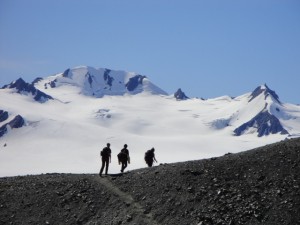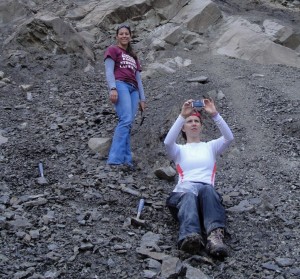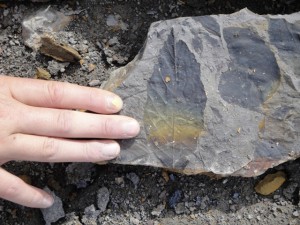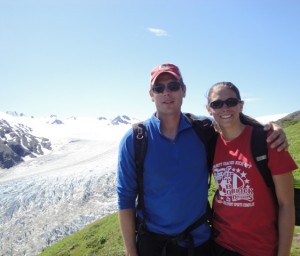
Students hike to Harding Icefield in Kenai Fiords National Park.
What can a 55 million-year-old leaf tell you about pre-historic temperatures and precipitation levels in Alaska? According to two Lafayette geology majors and their professor, quite a lot.
This summer, Jaclyn White ’13 (Clarksboro, N.J.) and Alexandria Brannick ’12 (Point Pleasant, N.J.) joined Dave Sunderlin, assistant professor of geology, on a research excursion to Alaska. There, the team studied leaf fossils in an effort to explore ancient plant and insect interaction.
“We had a project goal to gather a very large dataset on the fossil leaves from the Chickaloon Formation in Alaska, and we achieved it,” says Sunderlin. “We also were successful in collecting samples from rock layers that may help us tell exactly how many million years ago the leaves were entombed in an ancient river system.”

Alexandria Brannick '12, left, and Jaclyn White ’13 prospect for fossils near Wishbone Hill in Alaska.
By studying the fossils they collected, the team is attempting to get an idea of what the Alaskan climate was like 55 million years ago.
“Fossils of this time represent life during the Earth’s warmest climate phase in the past 65 million years,” says Sunderlin. “Now, we’re working on the fossil record of ancient forests as told by the remains of leaves, wood, seeds, flowers, amber, etc. The record of insects in amber and the traces of their feeding on leaves tell us of ecological interactions that were going on then.
“As high-latitude ecosystems experience increasingly warmer climates now, our research on these greenhouse-climate-phase fossil forests may give insight into what may be on the horizon for polar regions in the future.”
For the students, the trip was an opportunity to gain firsthand knowledge of field work.

Fossil leaf from the Chickaloon Formation in Alaska
“It was really amazing to have the opportunity to see what it is like to actually be in the field performing the methodology you read about in publications,” says Brannick, an aspiring paleontologist and a member of the College’s swimming team.
The team was focused on identifying leaf fossils and evidence of ancient insect interaction, but the learning went far beyond the original charge. For one thing, the group was able to experience the majestic beauty of Alaska up close.
“It was absolutely amazing. I was able to camp in one of the most beautiful places in the world, gain experience in paleontology, and work with great people all at the same time. And I had a ton of fun while doing it all,” says Brannick.

Professor David Sunderlin and Alexandria Brannick '12 near Exit Glacier.
The team also uncovered unexpected and exciting discoveries. White, for example, found a piece of rock that contained possible tracks of a mammal.
“We were looking for plants and herbivory, but we ended up finding possible footprints,” White says. “I was actually surprised by the amount of fossils we found. While I expected to find many, to find over 1,000 in two weeks was unexpected.”
The trip was part of a continuing research program funded by the Richard K. Mellon Foundation, Lafayette College, the Keck Geology Consortium, and the Geological Society of America. The team was accompanied by student and faculty researchers from Franklin & Marshall College. The research program already has produced copious data and results that have been presented in scientific journals, conference papers, and research talks. A paper relating to the research was published in June in the journal Palaios. Nancy Parker ’09, now a geologist for Denali National Park in Alaska, is a co-author of the paper.
Brannick and White will present their findings at professional meetings and co-author papers stemming from their research.
“The learning that happens with these types of student opportunities is so valuable in their development as scientists,” Sunderlin says.
For Brannick and White, the fieldwork was about more than professional preparation; it was about the thrill of discovery.
“Finding fossils is really exciting,” says White, who is also a midfielder on the College’s Division I field hockey team. “Each rock you find is a surprise. You don’t know whether it will be full of leaves and fossils or just standard sand and mud.”




1 Comment
Comments are closed.